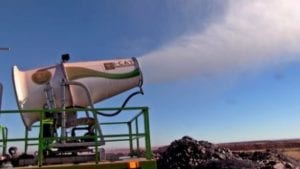An innovative evaporation system that incorporates proprietary water purification systems and misting canon technology may be the future of wastewater treatment.
This is according to I-CAT technical manager Morné van Wyk who indicates that the company’s new system for wastewater treatment has been well received by the local market and trials have proven that the concept is feasible. Van Wyk points out that the evaporation process can be carried out naturally in solar evaporation ponds, or by mechanical evaporation machines. “Natural solar evaporation is often limited by land availability and the cost of constructing additional storage ponds, not to mention the added cost of clean-up and re-vegetation,” he explains. This is where evaporation machines come in. According to van Wyk, these machines can rapidly increase the evaporation process, with minimal footprint. “Space can be utilised up to 14 times more efficiently than ponds, as evaporation machines are compact, reliable and efficient, and can be transported to numerous sites.” The evaporation machines can also be used as a low-cost addition to enhance evaporation on existing containment ponds, or to minimise new pond surface area. I-CAT environmental solutions currently offers two different types of evaporation solutions, namely water atomising evaporators and water fracturing evaporators.








